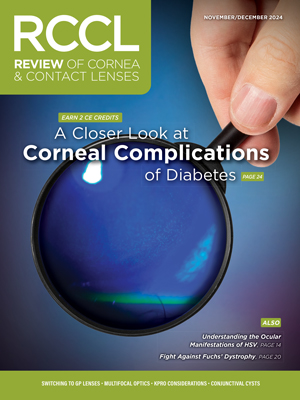 Ocular allergy represents an enormous therapeutic opportunity for optometry. An analysis of the National Health and Nutrition Examination Survey (NHANES) III data showed that ocular allergy symptoms, defined as “episodes of watery, itchy eyes,” affected 40% of the U.S. adult population during a 12-month period.1
Ocular allergy represents an enormous therapeutic opportunity for optometry. An analysis of the National Health and Nutrition Examination Survey (NHANES) III data showed that ocular allergy symptoms, defined as “episodes of watery, itchy eyes,” affected 40% of the U.S. adult population during a 12-month period.1
Prescription medication costs attributable to ocular allergy have increased substantially in the past decade to $200 million, and these costs are predicted to increase by approximately 25% annually.2 The overall incidence of allergies is steadily increasing, particularly in industrialized nations.3
Onset typically occurs in childhood and peaks in the second through fourth decades of life. It is often associated with a family history of atopic disease.4 The development of allergies may be influenced by early life environmental exposure to pollutants and infections by organisms that raise IgE levels throughout the body.5
How Allergies Can Affect the Eye
The eye is prone to develop allergic eye disease as airborne allergens easily impact the surface of the eye and initiate the allergic response in the conjunctiva.3 Ocular itching, conjunctival redness, conjunctival swelling, lid edema and tearing are common symptoms of allergic conjunctivitis.6
Treatment for allergic conjunctivitis includes non-pharmacologic interventions such as allergen avoidance, cold compresses and lubrication; pharmacologic treatments encompass both topical and systemic interventions—including decongestants, antihistamines, mast cell stabilizers, non-steroidal anti-inflammatory drugs (NSAIDs) and possibly intranasal corticosteroids (INSs).7 Although INSs are considered first-line treatment for nasal allergies, there is increasing evidence that INSs may alleviate some symptoms of ocular allergy as well.8
The Use of INS
INSs have traditionally been used for chronic management of nasal symptoms, and have also demonstrated an impact on decreasing ocular symptoms of itching, tearing and redness. Clinical data from as early as 1984 has indicated that INSs may by effective at relieving ocular symptoms of allergic rhinoconjunctivitis.9 Most recent studies found at least some positive effect on ocular allergy.10
There are currently seven INSs commercially available in the United States for treatment of seasonal and perennial allergic rhinitis in both adult and pediatric patients—beclomethasone, budesonide, ciclesonide, fluticasone propionate, fluticasone furoate, mometasone and triamcinolone.6 Evidence indicates that the ability of INSs to alleviate allergic eye symptoms is not particular to any single INS, but rather represents a class effect.11
The current intranasal preparations are well tolerated, with side effects limited to local irritation. Crusting, dryness and minor nosebleeds may occur in about 5% of patients. Although corticosteroids have potent systemic anti-inflammatory effects, systemic absorption of intranasal steroids—either through the nasal mucosa or GI tract—is below the level that would be expected to produce systemic effects, especially after it has been diluted by the blood before delivery to the eye.12
The risk of cataract formation associated with intranasal steroids is somewhat controversial and may be agent specific. A retrospective analysis of oral corticosteroid and intranasal steroid users showed that there was no increased incidence of cataract among intranasal steroids users.13 Some studies suggest a relationship between intranasal steroids and increased IOP. Large prospective studies to determine if there is a significant relationship between intranasal steroids and increased IOP are lacking.14
So, just as combination topical ocular medications can alleviate the symptoms in allergic rhinitis, we can consider using INSs to treat the ocular symptoms in allergic conjunctivitis. The efficacy of INS in treating nasal symptoms of seasonal and perennial allergic rhinoconjunctivitis is well established.
Growing evidence indicates that this class of medications may also be effective at relieving ocular symptoms. If both ocular and nasal symptoms can be controlled with a single agent, then treatment costs, medication compliance and patient satisfaction could improve dramatically in individuals with this very common presentation.
1. Singh K, Axelrod S, Bielory L. The epidemiology of ocular and nasal allergy in the United States. 1988–1994. J Allergy Clin Immunol. 2010 Oct;126(4):778-83.
2. Bielory L. Update on ocular allergy treatment. Expert Opin Pharmacother. 2002 May;3(5):541-53.
3. Bielory L. Ocular allergy overview. Immunol Allergy Clin North Am 2008; 28:1–23.
4. Bielory L, Friedlaender MH. Allergic conjunctivitis. Immunol Allergy Clin North Am. 2008 Feb;28(1):43-58.
5. Durham SR. Mechanisms of mucosal inflammation in the nose and lungs. Clin Exp Allergy. 1998 Jun;28(Suppl 2):11-6.
6. Origlieri C, Bielory L. Intranasal corticosteroids and allergic rhinoconjunctivitis. Curr Opin Allergy Clin Immunol. 2008 Oct;8(5):450-6.
7. Bielory L. Ocular allergy treatment. Immunol Allergy Clin North Am. 2008 Feb;28(1):189-224.
8. Martin BG, Andrews CP, van Bavel JH, et al. Comparison of fluticasone propionate aqueous nasal spray and oral montelukast for the treatment of seasonal allergic rhinitis symptoms. Ann Allergy Asthma Immunol. 2006 Jun;96(6):851-7.
9. Harries MG, Anderson PB, Gibson GJ, et al. A comparison of an aqueous and a pressurized nasal spray of beclomethasone dipropionate in the management of seasonal rhinitis. Pharmatherapeutica. 1984;3(9):623-5.
10. Origlieri C, Bielory L. Intranasal corticosteroids: do they improve ocular allergy? Curr Allergy Asthma Rep. 2009 Jul;9(4):304-10.
11. Bielory L. Intranasal corticosteroids reduce ocular symptoms of allergic rhinitis as a class effect. J Allergy Clin Immunol. 2008 Feb;121(2):538-9.
12. Mygind N, Nielsen LP, Hoffmann HJ et al. Mode of action of intranasal corticosteroids. J Allergy Clin Immunol. 2001 Jul;108(1 Suppl):S16–25.
13. Derby L, Maier WC. Risk of cataract among users of intranasal corticosteroids. J Allergy Clin Immunol. 2000 May; 105(5):912-6.
14. Bergmann J, Witmer MT, Slonim CB. The relationship of intranasal steroids to intraocular pressure. Curr Allergy Asthma Rep. 2009; 9(4):311-5.


